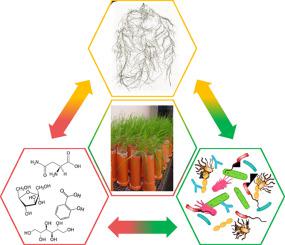当前位置:
X-MOL 学术
›
Appl. Soil Ecol.
›
论文详情
Our official English website, www.x-mol.net, welcomes your
feedback! (Note: you will need to create a separate account there.)
Relationships between root morphology, root exudate compounds and rhizosphere microbial community in durum wheat
Applied Soil Ecology ( IF 4.8 ) Pub Date : 2021-02-01 , DOI: 10.1016/j.apsoil.2020.103781 Anna Iannucci , Loredana Canfora , Franca Nigro , Pasquale De Vita , Romina Beleggia
Applied Soil Ecology ( IF 4.8 ) Pub Date : 2021-02-01 , DOI: 10.1016/j.apsoil.2020.103781 Anna Iannucci , Loredana Canfora , Franca Nigro , Pasquale De Vita , Romina Beleggia

|
Abstract A multidisciplinary approach was adopted to investigate multiple relationships between root morphology, rhizosphere soil exudates and soil microbial community in eight durum wheat [Triticum turgidum ssp. durum (Desf.)] cultivars previously characterized in terms of their ability to interact with mycorrhizal fungi. Six plants from each cultivar were grown to the five-leaf stage in a growth chamber. Root system architecture was characterized by root scans, root exudates were identified and quantified by gas chromatography–mass spectrometry (GC–MS), and the rhizosphere bacterial, archaeal and fungal community structure was assessed using terminal-restriction fragment length polymorphism (T-RFLP). Wheat cultivars were very different in terms of the morphological root traits. Cappelli, Grecale, Ofanto and PR22D89 cultivars showed the most developed root system. Root exudates included sugars, amino acids, polyalcohols and organic acids, with carbohydrates accounting for 87.3% of the whole data set. All the compounds showed significant differences among cultivars, with Grecale and Claudio showing the highest exudation ability of metabolites. T-RFLP profiles showed a greater relative abundance of bacterial taxa (55.8% on average) than those of archaea and fungi (35.6% and 8.6%, on average, respectively) in all cultivars, and responded positively to root exudation. Principal component analysis identified root dry weight, surface area and volume, carbohydrate exudation, bacterial and archaeal Shannon–Weaver diversity indices and the fungal evenness index as the traits that mainly contributed to the cultivar variability. A larger root system did not always promote a higher diversity of the rhizosphere microbial biomass. This then suggests complex interactions between traits, probably due to the differences in the quality and/or composition of the root exudates. Based on our results, we propose that durum wheat cultivars could be classified according to the different plant resource-use strategies employed, such as conservative (i.e. Cappelli, with a large root system but low exudation ability) and explorative/competitive (i.e. Grecale and Claudio, with a high exudation ability) cultivars. The results are discussed with reference to the complex relationships between the plant and the rhizospheric microorganisms in order to determine the best combinations that would enhance root efficiency.
中文翻译:

硬粒小麦根系形态、根系分泌物化合物与根际微生物群落的关系
摘要 采用多学科方法研究了八种硬粒小麦 [Triticum turgidum ssp.] 根系形态、根际土壤渗出物和土壤微生物群落之间的多重关系。durum (Desf.)] 栽培品种以前的特征在于它们与菌根真菌相互作用的能力。来自每个栽培品种的六株植物在生长室中生长至五叶期。根系结构通过根部扫描表征,根系分泌物通过气相色谱-质谱法 (GC-MS) 进行鉴定和量化,根际细菌、古菌和真菌群落结构通过末端限制性片段长度多态性 (T-RFLP) 进行评估)。小麦品种在形态根系性状方面差异很大。卡佩利、格雷卡勒、Ofanto 和 PR22D89 栽培品种显示出最发达的根系。根系分泌物包括糖类、氨基酸、多元醇和有机酸,其中碳水化合物占整个数据集的 87.3%。所有化合物在品种间表现出显着差异,其中 Grecale 和 Claudio 表现出最高的代谢物渗出能力。T-RFLP 谱显示所有品种中细菌类群的相对丰度(平均 55.8%)高于古细菌和真菌(平均分别为 35.6% 和 8.6%),并且对根系分泌物反应积极。主成分分析确定根干重、表面积和体积、碳水化合物渗出、细菌和古菌 Shannon-Weaver 多样性指数和真菌均匀度指数是导致品种变异的主要性状。更大的根系并不总是促进根际微生物生物量的更高多样性。这表明性状之间存在复杂的相互作用,可能是由于根系分泌物的质量和/或成分不同。根据我们的研究结果,我们建议硬粒小麦品种可以根据所采用的不同植物资源利用策略进行分类,例如保守型(即 Cappelli,根系大但渗出能力低)和探索性/竞争性(即 Grecale 和Claudio,具有高渗出能力)栽培品种。参考植物和根际微生物之间的复杂关系对结果进行讨论,以确定能够提高根系效率的最佳组合。这表明性状之间存在复杂的相互作用,可能是由于根系分泌物的质量和/或成分不同。根据我们的研究结果,我们建议硬粒小麦品种可以根据所采用的不同植物资源利用策略进行分类,例如保守型(即 Cappelli,根系大但渗出能力低)和探索性/竞争性(即 Grecale 和Claudio,具有高渗出能力)栽培品种。参考植物和根际微生物之间的复杂关系对结果进行讨论,以确定能够提高根系效率的最佳组合。这表明性状之间存在复杂的相互作用,可能是由于根系分泌物的质量和/或成分不同。根据我们的研究结果,我们建议硬粒小麦品种可以根据所采用的不同植物资源利用策略进行分类,例如保守型(即 Cappelli,根系大但渗出能力低)和探索性/竞争性(即 Grecale 和Claudio,具有高渗出能力)栽培品种。参考植物和根际微生物之间的复杂关系对结果进行讨论,以确定能够提高根系效率的最佳组合。我们建议硬粒小麦品种可以根据所采用的不同植物资源利用策略进行分类,例如保守型(即 Cappelli,根系大但渗出能力低)和探索性/竞争性(即 Grecale 和 Claudio,具有高渗出能力)栽培品种。参考植物和根际微生物之间的复杂关系对结果进行讨论,以确定能够提高根系效率的最佳组合。我们建议硬粒小麦品种可以根据所采用的不同植物资源利用策略进行分类,例如保守型(即 Cappelli,根系大但渗出能力低)和探索性/竞争性(即 Grecale 和 Claudio,具有高渗出能力)栽培品种。参考植物和根际微生物之间的复杂关系对结果进行讨论,以确定能够提高根系效率的最佳组合。
更新日期:2021-02-01
中文翻译:

硬粒小麦根系形态、根系分泌物化合物与根际微生物群落的关系
摘要 采用多学科方法研究了八种硬粒小麦 [Triticum turgidum ssp.] 根系形态、根际土壤渗出物和土壤微生物群落之间的多重关系。durum (Desf.)] 栽培品种以前的特征在于它们与菌根真菌相互作用的能力。来自每个栽培品种的六株植物在生长室中生长至五叶期。根系结构通过根部扫描表征,根系分泌物通过气相色谱-质谱法 (GC-MS) 进行鉴定和量化,根际细菌、古菌和真菌群落结构通过末端限制性片段长度多态性 (T-RFLP) 进行评估)。小麦品种在形态根系性状方面差异很大。卡佩利、格雷卡勒、Ofanto 和 PR22D89 栽培品种显示出最发达的根系。根系分泌物包括糖类、氨基酸、多元醇和有机酸,其中碳水化合物占整个数据集的 87.3%。所有化合物在品种间表现出显着差异,其中 Grecale 和 Claudio 表现出最高的代谢物渗出能力。T-RFLP 谱显示所有品种中细菌类群的相对丰度(平均 55.8%)高于古细菌和真菌(平均分别为 35.6% 和 8.6%),并且对根系分泌物反应积极。主成分分析确定根干重、表面积和体积、碳水化合物渗出、细菌和古菌 Shannon-Weaver 多样性指数和真菌均匀度指数是导致品种变异的主要性状。更大的根系并不总是促进根际微生物生物量的更高多样性。这表明性状之间存在复杂的相互作用,可能是由于根系分泌物的质量和/或成分不同。根据我们的研究结果,我们建议硬粒小麦品种可以根据所采用的不同植物资源利用策略进行分类,例如保守型(即 Cappelli,根系大但渗出能力低)和探索性/竞争性(即 Grecale 和Claudio,具有高渗出能力)栽培品种。参考植物和根际微生物之间的复杂关系对结果进行讨论,以确定能够提高根系效率的最佳组合。这表明性状之间存在复杂的相互作用,可能是由于根系分泌物的质量和/或成分不同。根据我们的研究结果,我们建议硬粒小麦品种可以根据所采用的不同植物资源利用策略进行分类,例如保守型(即 Cappelli,根系大但渗出能力低)和探索性/竞争性(即 Grecale 和Claudio,具有高渗出能力)栽培品种。参考植物和根际微生物之间的复杂关系对结果进行讨论,以确定能够提高根系效率的最佳组合。这表明性状之间存在复杂的相互作用,可能是由于根系分泌物的质量和/或成分不同。根据我们的研究结果,我们建议硬粒小麦品种可以根据所采用的不同植物资源利用策略进行分类,例如保守型(即 Cappelli,根系大但渗出能力低)和探索性/竞争性(即 Grecale 和Claudio,具有高渗出能力)栽培品种。参考植物和根际微生物之间的复杂关系对结果进行讨论,以确定能够提高根系效率的最佳组合。我们建议硬粒小麦品种可以根据所采用的不同植物资源利用策略进行分类,例如保守型(即 Cappelli,根系大但渗出能力低)和探索性/竞争性(即 Grecale 和 Claudio,具有高渗出能力)栽培品种。参考植物和根际微生物之间的复杂关系对结果进行讨论,以确定能够提高根系效率的最佳组合。我们建议硬粒小麦品种可以根据所采用的不同植物资源利用策略进行分类,例如保守型(即 Cappelli,根系大但渗出能力低)和探索性/竞争性(即 Grecale 和 Claudio,具有高渗出能力)栽培品种。参考植物和根际微生物之间的复杂关系对结果进行讨论,以确定能够提高根系效率的最佳组合。











































 京公网安备 11010802027423号
京公网安备 11010802027423号